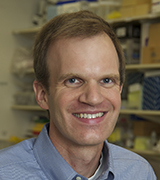Colleagues: Recently Tenured
SRIDHAR HANNENHALLI, PH.D., NCI-CCR
Senior Investigator, Cancer Data Science Laboratory, Center for Cancer Research, National Cancer Institute

Education: Indian Institute of Technology, Varanasi, India (B.Tech.); University of Central Florida, Orlando, Florida (M.S.); Pennsylvania State University, University Park, Pennsylvania (Ph.D.)
Training: Postdoctoral fellow, Department of Mathematics, University of Southern California (Los Angeles)
Before coming to NIH: Professor, Department of Cell and Molecular Biology, University of Maryland at College Park (College Park, Maryland) and professor, University of Maryland Institute for Advanced Computer Studies (College Park)
Came to NIH: In 2019
Outside interests: Argentine tango; running; playing tennis
Website: https://irp.nih.gov/pi/sridhar-hannenhalli
Research interests: Within the broad field of computational biology, we focus on eukaryotic gene regulation and evolution as it pertains to development and disease including cancer. We develop computational approaches that harness “big” biological data (genomes, epigenomes, transcriptomes, ChIP-seq, chromatin structure, etc.) to answer specific questions pertaining to these domains; a few examples are highlighted below.
We have developed statistical models, which incorporate established transcriptional mechanisms, to link genotype to gene expression as well as to detect single nucleotide polymorphism (SNP)-environment interactions. Such models are crucial in understanding the mechanisms underlying the genotype-phenotype links discovered by large-scale association studies. We are interested in extending these models to identify driver-regulatory mutations in cancer, and to investigate SNP-environment interactions in cancer.
In a collaboration exploring the role of 3-D chromatin structure in transcriptional regulatory mechanisms, we showed that estrogen receptors are pre-bound, in the absence of estrogen signaling, at specific loci in the genome. In the presence of signaling, however, these pre-bound sites mediate additional receptor binding in their relative vicinity. We will continue to investigate the role of chromatin structure in transcriptional regulation.
We have a long-standing interest in understanding context-specific changes in gene function. We developed network-based methods to characterize context-specific function of genes, as well as a data-driven method to identify clinically relevant gene interactions in cancer. Our findings help explain tissue-specific phenotypic manifestation of mutations.
We are also developing methodologies to exploit single-cell omics data to probe a variety of questions in development and in cancer. In a recent collaborative work, we compared the composition of tumor-infiltrating CD4 lymphocyte populations at the tumor and at draining lymph nodes. We discovered a type I interferon-driven signature in type 1–T-cell–like cells, also found in human liver cancer and melanoma, and negatively associated with response to checkpoint therapy.
PATRICIA JENSEN, PH.D., NIEHS
Senior Investigator, Neurobiology Laboratory, and Head, Developmental Neurobiology Group, National Institute of Environmental Health Sciences

Education: Florida Atlantic University, Boca Raton, Florida (B.S. in microbiology); University of Tennessee Health Science Center, Memphis, Tennessee (Ph.D. in anatomy and neurobiology)
Training: Postdoctoral fellow in developmental neurobiology, St. Jude Children’s Research Hospital (Memphis, Tennessee); postdoctoral fellow in genetics, Harvard Medical School (Boston)
Came to NIH: In 2009
Outside interests: Reading; drawing; gardening
Website: https://irp.nih.gov/pi/patricia-jensen
Research interests: My group studies how genetic and environmental challenges during development alter the functions of specific types of neurons later in life. My particular interest is in noradrenergic neurons, which release the flight-or-fight chemical called norepinephrine. Noradrenergic neurons modulate functions as diverse as attention, emotion, appetite, memory, and response to stress. Consistent with this functional diversity, norepinephrine signaling is disrupted in a spectrum of neurodegenerative and neurodevelopmental disorders and after exposure to a number of environmental toxicants. Interestingly, it has been observed that subsets of noradrenergic neurons are differentially susceptible to disease and certain environmental exposures. Given these observations, we suspect that the key to understanding noradrenergic-system dysfunction will not be found by focusing on the system as a whole. Rather, this phenotypic complexity will only be understood by uncovering the developmental and genetic factors that define unique functional subtypes of noradrenergic neurons.
Using genetically engineered mice that we designed, we defined subpopulations of noradrenergic neurons based on differences in embryonic gene expression. This novel molecular framework allowed us to determine where these populations are located in the adult mouse brain, what connections they make with other parts of the nervous system, and their role in stress-related behaviors. We found that some of the neurons behave the opposite of most noradrenergic neurons known to promote the stress response. In the mice, we identified a small subset of noradrenergic neurons that, when activated, decrease anxiety-like behavior and promote an active coping strategy in response to acute stressors.
My group is committed to using cutting-edge strategies to establish a body of knowledge that is already transforming our understanding of the noradrenergic system. Building on our molecular framework of the central noradrenergic system, we can now physically isolate unique subpopulations of noradrenergic neurons for molecular profiling or functionally manipulate them with unprecedented precision. Phenotypes resulting from these manipulations promise further insights into the biological roles of noradrenergic neurons and their differential response to disease and environmental insult.
LISA MIRABELLO, PH.D., NCI-DCEG
Senior Investigator, Clinical Genetics Branch, Division of Cancer Epidemiology and Genetics, National Cancer Institute

Education: Cornell University, Ithaca, New York (B.S. in pre-medicine and animal science); New York Medical College, Valhalla, New York (M.S. in experimental pathology); School of Public Health, State University of New York at Albany, New York (Ph.D. in biomedical sciences, molecular population genetics and infectious disease)
Training: Postdoctoral fellow, Clinical Genetics Branch, NCI-DCEG
Came to NIH: In 2007 for training; in 2013 became an Earl Stadtman tenure-track investigator, Genetic Epidemiology Branch, NCI-DCEG
Outside interests: Walking, hiking, and biking outdoors; playing with her son; traveling; gardening; listening to music; raising chickens and saltwater fish and coral
Website: https://irp.nih.gov/pi/lisa-mirabello
Research interests: My research program focuses on genetic susceptibility to pediatric cancer and the genomics of human papillomavirus (HPV) carcinogenicity.
In my pediatric cancer work, I primarily study osteosarcoma, which, although rare, is the most common type of bone cancer in children and teens. I am using epidemiologic studies to examine incidence patterns and identify risk groups for this cancer. I use whole-genome approaches, including large genome-wide association studies (GWAS) and whole-exome sequencing, to comprehensively explore the underlying genetic architecture of osteosarcoma. I have identified both common and rare inherited genetic loci associated with risk and clinical outcomes of osteosarcoma patients. My colleagues and I have completed the first international, multi-institution GWASes of osteosarcoma risk, osteosarcoma metastasis, and survival after osteosarcoma diagnosis. I am continuing to conduct large genomic epidemiologic studies of osteosarcoma and other pediatric cancers, in hopes of finding novel germ-line genetic markers of disease risk and outcomes.
In my HPV work, my group is studying the viral genetic basis of HPV carcinogenicity. HPV infections cause more than half a million cervical cancers a year. We have developed high-throughput HPV whole-genome sequencing methods that now enable large-scale HPV genomic studies. My HPV genomics project [https://dceg.cancer.gov/research/cancer-types/cervix/hpv-viral-genomics] has established that viral genetics play a pivotal role in HPV carcinogenesis and provide insight into why some infections progress to precancer and cancer and others do not. A primary focus is to evaluate why HPV type 16 (HPV16) is more carcinogenic than closely related types. By studying many thousands of carefully annotated HPV16 genomes from women with benign infections and those with precancer or cancer, I have identified important risk differences related to lineages and specific genetic variants of HPV16. My large viral genomic epidemiology studies are leading to new insights into the uniquely high carcinogenicity of HPV16, important regional carcinogenicity of HPV35, and the interplay of host-viral genetics, and the studies are uncovering important observations concerning HPV natural history.
JOHN “JAY” SCHNEEKLOTH JR., PH.D., NCI-CCR
Senior Investigator, Chemical Biology Laboratory, Center for Cancer Research, National Cancer Institute

Education: Dartmouth College, Hanover, New Hampshire (B.A. in chemistry); Yale University, New Haven, Connecticut (Ph.D. in chemistry)
Training: Postdoctoral fellow, Princeton University (Princeton, New Jersey)
Before coming to NIH: Medicinal chemist, Small Molecule Discovery Center, Yale University
Came to NIH: In 2011
Outside interests: Spending time with his wife and two sons; woodworking; playing baseball; listening to and playing music
Website: https://irp.nih.gov/pi/john-schneekloth
Research interests: My laboratory aims to develop small molecules that target RNA. Recent research has shown that some 85% of the three-billion base pairs in the human genome are transcribed into RNA, but just 3% of these transcripts code for protein sequences. Given that about 15% of proteins are druggable, targeting RNA represents a new opportunity to control noncoding functions of RNA molecules involved in disease or to block the expression of pathogenic proteins that, so far, cannot be targeted pharmacologically.
Our lab has developed a small-molecule microarray high-throughput screening platform that we use to rapidly identify and profile the binding of druglike small molecules to structured RNAs. With the aid of this technology, we are able to gain important insights into which RNA structures are targetable with drugs and the types of chemical compounds that bind to these targets. We have focused our work on targeting nucleic acids that regulate the expression of undruggable oncogenes such as c-MYC and K-RAS. In addition, we have investigated targeting functional RNAs from pathogenic organisms such as the human immunodeficiency virus. Our research allows us to develop a fundamentally new approach to developing therapeutics by targeting nucleic acids with drug molecules.
DOUGLAS R. STEWART, M.D., NCI-DCEG
Senior Investigator, Clinical Genetics Branch, Division of Cancer Epidemiology and Genetics, National Cancer Institute; Attending Physician and Adjunct Investigator, National Human Genome Research Institute

Education: Vassar College, Poughkeepsie, New York (B.A. in chemistry); University of Pennsylvania School of Medicine, Philadelphia (M.D.)
Training: Internship and residency, Department of Internal Medicine, Hospital of the University of Pennsylvania (Philadelphia); clinical fellow, Division of Human Genetics and Molecular Biology, and Division of Biochemical Genetics, The Children’s Hospital of Philadelphia (Philadelphia); Research Fellow, Department of Genetics, University of Pennsylvania School of Medicine
Came to NIH: In 2004 as part of NHGRI’s Physician Scientist Development Program; in 2010, became an Earl Stadtman tenure-track investigator in NCI-DCEG
Outside interests: Reading; traveling; spending time with his family
Website: https://irp.nih.gov/pi/douglas-stewart
Research interests: As a clinical geneticist, I investigate how genetic variation increases the risk of cancer. To do this, I study genetic data as well as tumors and other medical problems from cancer-prone families. Specifically, I have clinically and genetically studied multiple rare disorders, including neurofibromatosis type 1 (NF1), DICER1 syndrome, and the RASopathies.
NF1 is characterized by the presence of light-brown patches on the skin; benign growths on the iris; and skeletal abnormalities including scoliosis and bowing of the legs, large head size, learning disabilities, and an increased risk of developing certain benign and malignant tumors. DICER1 syndrome is a genetic disorder associated with an increased risk for developing benign or malignant tumors in the lungs, kidneys, ovaries, thyroid, and other locations in the body. RASopathies are caused by mutations in genes of the oncogene protein P21 (RAS)–mitogen-activated protein kinases (MAPK) pathway and are characterized by distinct facial features, developmental delays, cardiac defects, growth delays, neurologic issues, and gastrointestinal difficulties. There is an increased risk for cancer in people with some RASopathies; I am leading a new study focusing on that risk that will be launched soon at the NIH Clinical Center. Ultimately, I seek to develop gene-based approaches to help identify people for screening before they develop cancer.
In my work at NIH, I have evaluated many families at the NIH Clinical Center. Using the data from those visits, I have described novel medical problems of NF1 and the DICER1 syndrome, developed cancer risk estimates and written clinical-care guidelines. This work helps to identify and manage people with NF1 and the DICER1 syndrome. In addition, I have worked on finding genes that increase risk for a variety of pediatric cancers, in particular, neuroblastoma and rhabdomyosarcoma.
Looking ahead, there are many opportunities in clinical genetics, especially as the cost of sequencing continues to drop. An important question is how to best work genetic data into everyday care. I am leading a new NCI-funded effort to study exome data (sequencing information on all of the genes) from tens of thousands of people. We focus on the people with the most worrisome genetic variations in cancer-associated genes and then query their linked medical records. I hope that this new, “genome-first” approach will guide us to people at risk, rather than waiting for a problem (such as cancer) to appear.
This page was last updated on Wednesday, March 30, 2022
